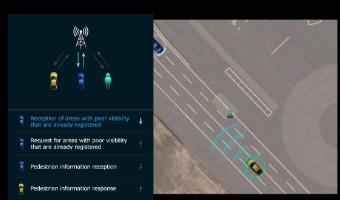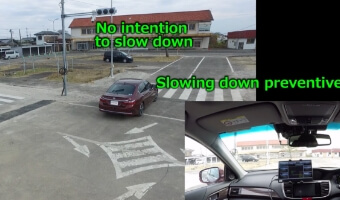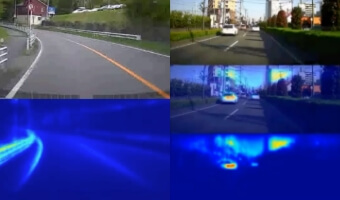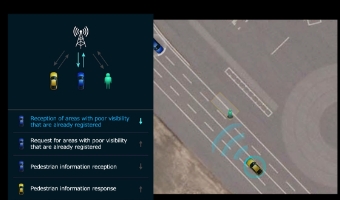Innovative Research
Excellence
Research on Innovative and Unique Technologies
Aiming for the realization of a “society with zero environmental impact” and a “society with zero traffic accident fatalities,” the Innovative Research Excellence center J6:J16has been striving to research the technologies as follows:
- recycling technologies and next-generation electrification technologies to reduce environmental impact,
- technologies to understand humans and expand their ability so that every person can obtain his or her peace of mind,
- secure and safe technologies required for all traffic participants including motorcycles and automobiles to coexist, and
- innovative production technologies looking into the future.

Linking V2P and ADAS Technologies
We have been researching the technology to reduce accidents by utilizing AI, 5G, and cellular V2X communication, aiming for the realization of a society where pedestrians and vehicles can move safely and securely. The system enables the AI of the cameras on board to detect a pedestrian entering a roadway, and to alert him or her to the approach of a vehicle by communication with the pedestrian’s smartphone. The system also enables each other to pay attention by identifying not only the areas that cannot be seen very well, due to the obstacles such as parked automobiles along roadways, but the presence of pedestrians in the area with a smartphone or the camera of the ongoing vehicle. In the future, various risks in the streets will be compiled into the server, and the technology will be expanded to the cooperative safety system that can encourage traffic participants to take action in advance to avoid risks.

Intelligent Mobility
We have been researching Cooperative Intelligence that can independently understand not only the ambient environment but a person’s intention and action, and that can communicate with each other through behavior and/or language to take cooperative action. We provide people with the three “at wills” to realize the safe, secure, and free mobility of people and things by applying Cooperative Intelligence to the autonomous driving system, driving assistance system, riding micro-mobility, and micro-mobility robots.
Autonomous driving: Move freely “at will” under automation
Driving assistance: Drive confidently “at will” by oneself
Micro-mobility: Use “at will” easily anytime, anywhere

AI Driver Model
The research of visual behaviors and brains has shown that a beginner or an elderly driver cannot afford to drive his or her vehicle looking around. It is thought that this results in the anxiety for driving or an accident. The AI caution assumption model, first developed by Honda ahead of other companies, notifies a beginner or young driver of the risks predicted, resulting in safe action “by himself or herself” at an earlier stage. Elderly drivers tend to be delayed in responding to the events such as the yawing of a vehicle and a delay in braking, which leads to anxiety for driving or an accident. We have been researching the operation assistance that will guide the drivers so as not to have the yawing problem thanks to the driving action model of the AI by grasping the characteristics of elderly drivers.

Next-Generation HMI
Using AI and next-generation HMI, we are working on research into the technologies that keep risks away from approaching and prevent any risks from being overlooked. Specifically, being based on AI’s risk prediction and understanding of the driver’s condition, the HMI technology notifies the driver of the increased risk intelligibly by using a risk indicator (visual), seat belt control (tactile), stereophonic sound (auditory), etc.; and reduces the driver’s drowsiness or distraction with biofeedback. We aim to provide new value of safety and security through appropriate driving assistance depending on each driver’s cognitive state and traffic scene.

All-Solid-State Battery
The expectations for the batteries on board are low cost and the increase in the cruising range. The battery under development uses a higher-capacity anode than usual, but its high activity causes a side reaction with the electrolyte, resulting in low charge-discharge efficiency. In addition, lithium dendrite growth during charging is a safety concern. We try to solve these problems by adopting a solid electrolyte. Moreover, we aim for the electrodes that can be mass-produced at low cost. To realize their high-speed mass production, we have been striving to establish both making slurry and painting of cathode composite, as well as a roll press process to ensure the electrode packing density and interface adhesion. Furthermore, to maximize the energy density, we have been working on making the materials into thinner layers that do not contribute to energy.

eVTOL
We provide our customers with the “joy and the freedom of mobility,” and our vision is to “produce their motivation so that they will be pleased to act.” To make the mobility in the skies, which we realized with our pioneer HondaJet, even more accessible, we have been developing eVTOL (electric Vertical Take-Off and Landing) by taking advantage of a wide range of various core technologies.

Avatar Robot
A user can “experience” things and perform “tasks” as a second self of the user without being there in person. We position the avatar robot as 4-dimensional mobility beyond the 2-dimensional and 3-dimensional space-time. We consider the robot as “self-expansion without being bound by the constraints of time, space, or ability,” as well as “beyond-space-time expansion of the fields where human beings can act.” Aiming to create the robot that can work adapting to the environment where people live, we are striving to research and develop a human-like robotic hand that is “sensitive” and “powerful” and “AI-supported remote control technology” that corrects the discrepancies between human and robot vision or tactile sensation in order for a user to operate it freely.

Space Transportation
With a view to expanding the range of human activities and enriching the lives of people on the ground through the use of space, we are conducting research and development on our original reusable small rocket, focusing on its affinity with and applicability to Honda’s core technology, in order to make space transportation more accessible, which is a bottleneck for human activities.
- Field
- Innovative Research Excellence
- Innovative Research Excellence,
Power Unit & Energy - Design Center
- Material Research Center
- Corporate Development Center











